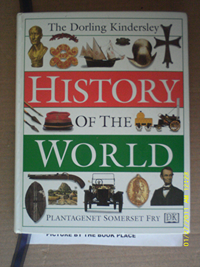The Dorling Kindersley History of the World
Material type: TextLanguage: English Publication details: New York : D. Kindersley LTD, 1994Edition: 1st American edDescription: 384 p. : col. illISBN:
TextLanguage: English Publication details: New York : D. Kindersley LTD, 1994Edition: 1st American edDescription: 384 p. : col. illISBN: - 9781564582447
- 909 FRY
| Item type | Current library | Shelving location | Call number | Copy number | Status | Date due | Barcode |
|---|---|---|---|---|---|---|---|
 Reference Collection
Reference Collection
|
City Campus Library | City Campus | 909 FRY | 2024-2025 | Available | 98769 |
Summary:
This ambitious and colorful volume covers the history of the world from the beginnings of life on earth to the 1990's in 384 pages of mostly pictures. The 20 chapters are arranged chronologically with catchy titles such as "Conquest and Plague" to go along with the dates included in the chapter heading. At the beginning of each chapter is a double-page world map with pictures illustrating some of the major developments during that particular era. A brief narrative introduces the chapter and a timeline, divided into regions-Oceania, America, Europe, Asia and Africa-covers the next two pages. The timeline is illustrated with pictures of models or artifacts. Then a series of pages is devoted to narrative and illustration of some of the events of that chapter's era in each of the regions. Insert maps, photographs, biographical sketches, and drawings are prominent. There are supplementary reference pages which have more timelines featuring architecture, population, inventions, and the modern world, and some United States fact tables. There is a two-page glossary. The index is neither complete nor well-organized; the listing for Czechoslovakia, for example, has a hard-to-find reference on a timeline, but does not mention more information on another page, no doubt because the heading there is a reference to the "Prague Spring" and is listed in the index only under Prague. The issues discussed on these pages are never resolved by any reference in the index, or the text, for that matter, to the Velvet Revolution or the division of the country. Students will be left thinking the intellectuals of "Czechoslovakia" are still debating communism. The difficulties of sustaining continuity in this sort of work are obvious. The reference use of this history will be limited to browsing for a topic to research elsewhere. Nonetheless, the volume will be visually appealing to many students in elementary and middle school
